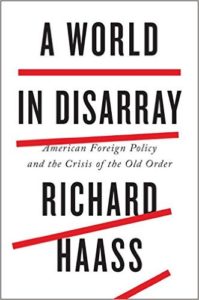This book review of Richard Haass’ A World in Disarray first appeared in the Winter 2017 issue of Providence’s print edition. To read the original in a PDF form, click here. To subscribe and receive complete copies of future issues for only $28 a year, click here.
In 1947, between a second world war and a cold one, Secretary of State George Marshall formed the Policy Planning Staff at the State Department, directing it “to devise basic policies crucial to the conduct of our foreign affairs.” Present at the creation as its first director was diplomat George Kennan, who’s anonymous “X” article in Foreign Affairs the same year first framed the U.S. strategy of containment against Soviet communism.
Kennan was a realist who advocated a singular focus on national interests and saw the world through the prism of power politics. He sought the counsel of other realists, including practitioners, theorists, and even a theologian—Reinhold Niebuhr. Together, they helped bring order to a world in disarray, crafting policy that would position the U.S. opposite the USSR and at the center of defense alliances and market economies uniting the free world.
 Seventy years later, a successor of Kennan, Richard Haass, similarly seeks to bring order to a world in disarray with a new book of that title. Haass served as the first director of Policy Planning in the George W. Bush administration; for the last 14 years, he has served as president of the Council on Foreign Relations, publisher of Foreign Affairs. Like his predecessor at State, Haass is a self-described “card-carrying realist”; unlike Kennan, however, Haass’ realism is chastened by the Iraq War, over which he resigned his position at State in protest. As one would expect, his brand of realism is notably conservative in its prescriptions and minimalist in its ambitions.
Seventy years later, a successor of Kennan, Richard Haass, similarly seeks to bring order to a world in disarray with a new book of that title. Haass served as the first director of Policy Planning in the George W. Bush administration; for the last 14 years, he has served as president of the Council on Foreign Relations, publisher of Foreign Affairs. Like his predecessor at State, Haass is a self-described “card-carrying realist”; unlike Kennan, however, Haass’ realism is chastened by the Iraq War, over which he resigned his position at State in protest. As one would expect, his brand of realism is notably conservative in its prescriptions and minimalist in its ambitions.
This prudence does not prevent Haass from recognizing radical threats to international order, however. Indeed, he is at his best in describing the disruptive forces wrought by globalization, including transnational terrorism, nuclear proliferation, pandemic disease, cyber warfare, and climate change. “Almost anyone and anything, from tourists, terrorists, and both migrants and refugees, to e-mails, weapons, viruses, dollars and greenhouse gases, can travel on one of the many conveyer belts that are modern globalization and reach any and every corner of the globe.” Given this new reality, a traditional realism “that speaks only to the rights and prerogatives of states,” Haass asserts, “is increasingly inadequate, even dangerous.”
Haass’ solution is to redefine realism based on a new understanding of sovereignty. Inspired by the Concert of Europe that restored stability following the Napoleonic Wars, he calls for a new sense of “sovereign obligation” such as that voluntarily assumed by Metternich, Castlereagh, Tallyrand, and the other envoys of the continent’s royal courts two centuries ago. Sovereignty, Haass urges, must extend beyond respect for the territorial integrity and domestic autonomy of states to encompass the duties states have to one another. A state’s independence is dependent upon its cooperation in the maintenance of a stable international order.
Although Haass’ innovation is impressive and his defense of realism admirable, it suffers from a crucial flaw. In the current context, in which the United States remains “the most powerful country in the world for decades to come,” Haass’ renewed realist paradigm points to a paradox. If world order is in U.S. national interests and such order requires a balance of power, it follows that it is in the interests of the world’s predominant power to elevate one or more states to serve as a counterbalance, either by strengthening them, or weakening ourselves. Is such national self-sacrifice politically realistic? Would Americans willingly cede an advantage to a rival in the interests of a balanced world order? The question answers itself.
The implications of Haass’ realism are not only politically unrealistic. They are also morally unconscionable. The British Empire managed its decline and a rebalancing of world order by encouraging the growth of the United States, a like-minded liberal democracy. No such alternative exists today. Neither Russia nor China, the world’s other contenders for predominance, are liberal states likely willing to enforce a liberal world order. The manner by which their authoritarian regimes manage competing domestic power centers and use force internally are indicative of their intentions to uphold a stable, peaceful, and just international order. Repressive regimes tend to become rogue ones.
On the other hand, an America unbound is also unlikely to foster global stability, if only because it would breed resentment and provoke challenge. The necessary check on our own power, then, must come from within, rather than from without. Structurally, our constitutional separation of powers and democratic institutions limit overreach, but these are only as effective as the people that comprise them. Ultimately, self-discipline—for nations as with individuals—entails moral struggle. It is a test not of our compliance with domestic or international law, but of our commitment to abide by a higher law, one that respects dignity, supports flourishing, and seeks justice for all.
Here realism is blind. Haass insists on the strict separation of the moral from the material in foreign affairs, consistent with classic realism. An example of this is his strained distinction, bordering on the semantic, between “sovereign obligation” and “sovereign responsibility.” The former speaks only to states’ duties to one another; the latter, captured in the emerging norm of the Responsibility to Protect, addresses states’ duties to their citizens, and the duty of all states to protect innocents. Per Haass, to preserve world order, sovereignty must be made dependent on a state meeting its obligations, such as preventing terrorists from operating from their territory or limiting its greenhouse gas emissions. It is not contingent on it fulfilling its responsibilities, such as preventing mass atrocities within its territory. But is such a separation sensible, especially in an increasingly porous world? It is revealing that in his brief summary in the book of just war doctrine—a doctrine he elsewhere dismisses as too “subjective”—Haass omits entirely the criterion of right intention, arguably the most critical from a moral perspective. His new concept of sovereignty remains indifferent to the character and intentions of the states that claim it, viewing all as morally equivalent.
In his own recent book on sovereignty, eminent just war scholar James Turner Johnson excavates the concept to discover that in fact it was a moral one from its inception. Sovereignty, in Roman jurisprudence and Christian thought, was understood as “responsibility for the common good of society that is to be exercised to vindicate justice.” It was a sacred duty reserved for leaders with no secular superior (souverain in the old French) and constituted the grounds for granting them the sole right to wield organized, deadly force. Only after the Peace of Westphalia in 1648—realism’s Genesis—was sovereignty shorn of responsibility and reduced to the rights of territorial integrity and domestic inviolability.
Unless Americans cultivate a sense of moral responsibility in our foreign policy, promoting universal justice as well as national interest, we risk falling into what Haass refers to as the Thucydides Trap: a world order, like that of ancient Peloponnesian Greece, in which vying powers react on their worst fears of others and the hegemons suppress rising competitors. While, as the strongest power today, the United States could benefit from such a ruthless system, history suggests the rewards would be fleeting, for in such conditions the outbreak of war becomes almost inevitable, and the only peace is that of the graveyard. No sovereign obligations assumed by others would keep mankind from blundering into the trap, and Thucydides’ snare would be sprung. It is our unique duty, therefore, as the world’s undisputed leader, to ensure the world order we shape serves not only our national interests but the common interest as well.
During their time together at the State Department and beyond, George Kennan and Reinhold Niebuhr carried on a lively correspondence reflecting their deep regard and respect for one another. It was Kennan who famously called Niebuhr “the father of us all.” On most matters, they were in strong agreement. But the two realists differed in one important way: the role of morality in foreign affairs. Kennan asserted that prudence dictates that national interests “have no moral quality.” Niebuhr, on the other hand, believed it necessary “to draw upon another moral and spiritual resource to widen the conception of interest… a sense of justice that can prevent prudence from inevitably arresting the impulse toward, and concern for, the life of the other.” His realism was a Christian realism, shaped by a more enlightened ethic than the cynical egoism that classic realism can fall prey to. It was a realism that recognized our fallen nature but also our transcendent destiny. It was a realism informed by hope as well as sin.
With his novel concept of sovereign obligation, Haass makes an important advance in the search for peace and stability in a disoriented world. For this reason, his book deserves a place among the modern classics of realism. But its advances fall short, unable to grasp the essential moral quality of world order, especially one in which to balance power today would require empowering illiberal states. Without the influence and inspiration of a moral guide such as Kennan had with Niebuhr, Haass’ renewed realism remains a paradigm lost.
—
Matt Gobush served on the staff of the National Security Council in the Clinton White House, the U.S. Department of Defense, the U.S. Senate, and the U.S. House of Representatives International Relations Committee. He also served as chairman of the Episcopal Church’s Standing Commission on Anglican and International Peace with Justice Concerns. He currently works in the private sector and lives in Dallas, Texas with his wife and three internationally adopted children.
Photo Credit: A U.S. flag hangs in front of a burning structure in Black Forest, Colo., June 12, 2013. Image Credit: U.S. Department of Defense photo by Master Sgt. Christopher DeWitt, U.S. Air Force.






